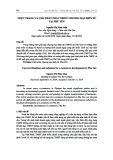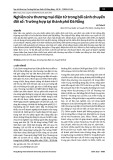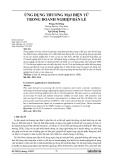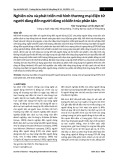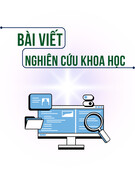
Appendix A
Infrastructure for Electronic Commerce
Regardless of their basic purpose, virtually all e-commerce sites rest on the same network structures,
communication protocols, and Web standards. This infrastructure has been under development for over 30
years. This appendix briefly reviews the structures, protocols and standards underlying the millions of sites
used to sell to, service, and chat with both customers and business partners. It also looks at the infrastructure
of some newer network applications, including streaming media and peer-to-peer (P2P).
A.1 NETWORK OF NETWORKS
While many of us use the Web and the Internet on a daily basis, few of us have a clear understanding of its
basic operation. From a physical standpoint, the Internet is a network of 1000s of interconnected networks.
Included among the interconnected networks are: (1) the interconnected backbones which have international
reach; (2) a multitude of access/delivery sub-networks; and (3) thousands of private and institutional
networks connecting various organizational servers and containing much of the information of interest. The
backbones are run by the network service providers (NSPs) which include the major telecommunication
companies like MCI and Sprint. Each backbone handles hundreds of terabytes of information per month.
The delivery sub-networks are provided by the local and regional Internet Service Providers (ISPs). The
ISPs exchange data with the NSPs at the network access points (NAPs). Pacific Bell NAP (San Francisco)
and Ameritech NAP (Chicago) are examples of these exchange points.
When a user issues a request on the Internet from his or her computer, the request will likely traverse an
ISP network, move over one or more of the backbones, and across another ISP network to the computer
containing the information of interest. The response to the request will follow a similar sort of path. For any
given request and associated response, there is no preset route. In fact the request and response are each
broken into packets and the packets can follow different paths. The paths traversed by the packets are
determined by special computers called routers. The routers have updateable maps of the networks on the
Internet that enable them to determine the paths for the packets. Cisco (www.cisco.com) is one of the
premier providers of high speed routers.
One factor that distinguishes the various networks and sub-networks is their speed or bandwidth. The
bandwidth of digital networks and communication devices are rated in bits per second. Most consumers
connect to the Internet over the telephone through digital modems whose speeds range from 28.8 kbps to 56
kbps (kilobits per second). In some residential areas or at work, users have access to higher-speed
connections. The number of homes, for example, with digital subscriber line (DSL) connections or cable
connections is rapidly increasing. DSL connections run at 1 to 1.5 mbps (megabits per second), while cable
connections offer speeds of up to 10 mbps. A megabit equals 1 million bits. Many businesses are connected
to their ISPs via a T-1 digital circuit. Students at many universities enjoy this sort of connection (or
something faster). The speed of a T-1 line is 1.544 mbps. The speeds of various Internet connections are
summarized in Table A.1.
. You’ve probably heard the old adage that a chain is only as strong as its weakest link. In the Internet
the weakest link is the “last mile” or the connection between a residence or business and an ISP. At 56 kbps,
downloading anything but a standard Web page is a tortuous exercise. A standard Web page with text and
graphics is around 400 kilobits. With a 56K modem, it takes about 7 seconds to retrieve the page. A cable
modem takes about .04 seconds. The percentage of residences in the world with broadband connections (e.g.
cable or DSL) is very low. In the U.S. the figure is about 4% of the residences. Obviously, this is a major
impediment for e-commerce sites utilizing more advanced multi-media or streaming audio and video
technologies which require cable modem or T-1 speeds.
Appendix A Infrastructure for Electronic Commerce 1

TABLE A.1 Bandwidth Specifications
Technology Speed Description Application
Digital Model 56 Kbps Data over public
telephone networks
Dialup
ADSL – Asynchronous
Digital Subscriber line
1.5 to 8.2 Mbps Data over public
telephone network
Residential and
commercial hookups
Cable Modem 1 to 10 Mbps Data over the cable
network
Residential hookups
T-1 1.544 Mbps Dedicated digital circuit Company backbone to
ISP
T-3 44.736 Mbps Dedicated digital circuit ISP to Internet
infrastructure. Smaller
links in Internet
infrastructure
OC-3 155.52 Mbps Optical fiber carrier Large company
backbone to Internet
backbone
OC-12 622.08 Mbps Optical fiber carrier Internet backbone
OC-48 2.488 Gbps Optical fiber carrier Internet backbone. This
is the speed of the
leading edge networks
(e.g. Internet2 – see
below)
OC-96 4.976 Gbps Optical fiber carrier Internet backbone
A.2 INTERNET PROTOCOLS
One thing that amazes people about the Internet is that no one is officially in charge. It’s not like the
international telephone system that is operated by a small set of very large companies and regulated by
national governments. This is one of the reasons that enterprises were initially reluctant to utilize the Internet
for business purposes. The closest thing the Internet has to a ruling body is the Internet Council for
Assigned Names and Numbers (ICANN). ICANN (www.icann.org) is a non-profit organization that was
formed in 1998. Previously, the coordination of the Internet was handled on an ad hoc and volunteer basis.
This informality was the result of the culture of the research community that originally developed the
Internet. The growing business and international use of the Internet necessitated a more formal and
accountable structure that reflected the diversity of the user community. ICANN has no regulatory or
statutory power. Instead, it oversees the management of various technical and policy issues that require
central coordination. Cooperation with those policies is voluntary. Over time, ICANN has resumed
responsibility for four key areas: the Domain Name System (DNS); the allocation of IP address space; the
management of the root server system; and the coordination of protocol number assignment. All four of
these areas form the base around with the Internet is built.
A recent survey published in March 2001 by the Internet Software Consortium (www.isc.org) revealed
that there were over 109 million connected computers on the Internet in 230 countries. The survey also
estimated that the Internet was adding over 60 new computers per minute worldwide. Clearly, not all of these
computers are the same. The problem is: how are these different computers interconnected in such a way that
they form the Internet? Loshin (1997) states the problem this way:
The problem of internetworking is how to build a set of protocols that can handle communications
between any two (or more) computers, using any type of operating system, and connected using any
kind of physical medium. To complicate matters, we can assume that no connected system has any
knowledge about the other systems: there is no way of knowing where the remote system is, what
kind of software it uses, or what kind of hardware platform it runs on.
Appendix A Infrastructure for Electronic Commerce 2

A protocol is a set of rules that determine how two computers communicate with one another over a network.
The protocols around which the Internet was and still is designed embody a series design principles (Treese
and Stewart, 1998):
•Interoperable – the system support computers and software from different vendors. For e-commerce this
means that the customers or businesses are not required to buy specific systems in order to conduct
business.
•Layered – the collection of Internet protocols work in layers with each layer building on the layers at
lower levels. This layered architecture is shown in Figure A.1.
•Simple – each of the layers in the architecture provides only a few functions or operations. This means
that application programmers are hidden from the complexities of the underlying hardware.
•End-to-End – the Internet is based on “end-to-end protocols.” This means that the interpretation of the
data happens at the application layer (i.e., the sending and receiving side) and not at the network layers.
It’s much like the post office. The job of the post office is to deliver the mail, only the sender and
receiver are concerned about its contents.
FIGURE A.1 TCP/IP Architecture
Application Layer
FTP, HTTP, Telnet, NNTP
Transport Layer
Transmission
Control Protocol
(TCP)
User
Datagram Protocol
(UDP)
Internet Protocol (IP)
Network Interface Layer
Physical Layer
TCP/IP
The protocol that solves the global internetworking problem is TCP/IP, the Transmission Control Protocol/
Internet Protocol. This means that any computer or system connected to Internet runs TCP/IP. This is the
only thing these computers and systems share in common. Actually, as shown in Figure A.1, TCP/IP is two
protocols – TCP and IP -- not one.
TCP ensures that two computers can communicate with one another in a reliable fashion. Each TCP
communication must be acknowledged as received. If the communication is not acknowledged in a
reasonable time, then the sending computer must retransmit the data. In order for one computer to send a
request or a response to another computer on the Internet, the request or response must be divided into
packets that are labeled with the addresses of the sending and receiving computers. This is where IP comes
into play. IP formats the packets and assigns addresses.
The current version of IP is version 4 (IPv4). Under this version, Internet addresses are 32 bits long and
written as four sets of numbers separated by periods, e.g., 130.211.100.5. This format is also called dotted
Appendix A Infrastructure for Electronic Commerce 3

quad addressing. From the Web, you’re probably familiar with addresses like (www.yahoo.com). Behind
every one of these English-like addresses is a 32-bit numerical address.
With IPv4 the maximum number of available addresses is slightly over 4 billion (2 raised to the 32
power). This may sound like a large number, especially since the number of computers on the Internet is still
in the millions. One problem is that addresses are not assigned individually but in blocks. For instance, when
Hewlett Packard (HP) applied for an address several years ago, they were given the block of addresses
starting with “15.” This meant that HP was free to assign more than 16 million addresses to the computers in
the networks ranging from 15.0.0.0 to 15.255.255.255. Smaller organizations are assigned smaller blocks of
addresses.
While block assignments reduce the work that needs to be done by routers (e.g. if an address starts with
“15”, then it knows that it goes to a computer on the HP network), it means that the number of available
addresses will probably run out over the next few years. For this reason, various Internet policy and
standards boards began in the early 1990’s to craft the next generation Internet Protocol (IPng). This
protocol goes by the name of IP version 6 (IPv6). IPv6 is designed to improve upon IPv4's scalability,
security, ease-of-configuration, and network management. By early 1998 there were approximately 400 sites
and networks in 40 countries testing IPv6 on an experimental network called the 6BONE (King et. al., 2000).
IPv6 utilizes 128 bit addresses. This will allow one quadrillion computers (10 raised to the 15th power) to be
connected to the Internet. Under this scheme, for instance, one can imagine individual homes having their
own networks. These home networks could be used to interconnect and access not only PCs within the home
but also a wide range of appliances each with their own unique address.
Domain Names
Names like “www.microsoft.com” that reference particular computers on the Internet are called domain
names. Domain names are divided into segments separated by periods. The part on the very left is the name
of the specific computer, the part on the very right is the top-level domain to which the computer belongs, and
the parts in between are the subdomains. In the case of “www.microsoft.com” the specific computer is
“www,” the top level domain is “com,” and the subdomain is “microsoft.” Domain names are organized in a
hierarchical fashion. At the top of the hierarchy is a root domain. Below the root are the top level domains
which originally included “com,” “edu,” “gov,” “mil,” “net,” “org,” and “int.” Of these, the “com,” “net,”
and “edu” domains represent the vast majority (73 million out of 109 million) of the names. Below each top
level domain is the next layer of subdomains, below which another layer of subdomains, etc. The leaf nodes
of the hierarchy are the actual computers.
When a user wishes to access a particular computer, they usually do so either explicitly or implicitly
through the domain name, not the numerical address. Behind the scenes, the domain name is converted to the
associated numerical address by a special server called the domain name server (DNS). Each organization
provides at least two domain servers, a primary server and a secondary server to handle overflow. If the
primary or secondary server cannot resolve the name, the name is passed to the root server and then on to the
appropriate top level server (e.g. if the address is “www.microsoft.com,” then it goes to the “com” domain
name server). The top level server has a list of servers for the subdomains. It refers the name to the
appropriate subdomain and so on down the hierarchy until the name is resolved. While several domain name
servers might be involved the process, the whole process usually takes microseconds.
As noted earlier, ICANN coordinates the policies that govern the domain name system. Originally,
Network Solutions Inc. was the only organization with the right to issue and administer domain names for
most of the top level domains. A great deal of controversy surrounded their government-granted monopoly
of the registration system. As a result, ICANN signed a memorandum of understanding with the Department
of Commerce that resolved the issue and allowed ICANN to grant registration rights to other private
companies. A number of other companies are now accredited registrars (e.g. America Online, CORE, France
Telecom, Melbourne IT, and register.com).
Anyone can apply for a domain name. Obviously, the names that are assigned must be unique. The
difficulty is that across the world several companies and organizations have the same name. Think how many
companies in the U.S. have the name “ABC.” There’s the television broadcasting company, but there’s also
stores like ABC Appliances. Yet, there can only be one “www.abc.com.” Names are issued on a first-come-
first-serve basis. The applicant must affirm that they have the legal right to use the name. If disputes arise,
then the disputes are settled by ICANN’s Uniform Domain Name Dispute Resolution Policy or they can be
settled in court.
Appendix A Infrastructure for Electronic Commerce 4

New World Network: Internet2 and Next Generation Internet (NGI)
It’s hard to determine and even comprehend the vast size of the Web. Sources estimate that by February,
1999 the Web contained 800 million pages and 180 million images. This represented about 18 trillion bytes
of information (Small, 2001). By February of 2000, estimates indicated that these same figures had doubled.
As noted earlier, the number of servers containing these pages is over 100 million and is growing at a rate of
about 50% per year. In 1999 the number of Web users was estimated to be 200 million. By 2000, the
number was 377 million and by August, 2001 the figure was 513 million (about 8% of the worlds
population). Whether these figures are exactly right is unimportant. The Web continues to grow at a very
rapid pace. Unfortunately, the current data infrastructures and protocols were not designed to handle this
amount of data traffic for this number of users. Two consortiums, as well as various telecoms and
commercial companies, have spent the last few years constructing the next generation Internet.
The first of these consortiums is the University Corporation for Advanced Internet Development
(UCAID, www.ucaid.edu). UCAID is a non-profit consortium of over 180 universities working in
partnership with industry and government. Currently, they have three major initiatives underway –
Internet2, Abilene and The Quilt.
The primary goals of Internet2 are to:
•Create a leading edge network capability for the national research community
•Enable revolutionary Internet applications
•Ensure the rapid transfer of new network services and applications to the broader Internet
community.
Internet2’s leading edge network is based on a series of interconnected gigapops – the regional, high-
capacity points of presence that serve as aggregation points for traffic from participating organizations. In
turn these gigapops are interconnected by a very high performance backbone network infrastructure.
Included among the high speed links of Abilene, vBNS, CA*net3 and many others. Internet2 utilizes IPv6.
The ultimate goal is to connect universities so that a 30 volume encyclopedia can be transmitted in less than a
second and to support applications like distance learning, digital libraries, video conferencing, virtual
laboratories, and the like.
The third initiative, The Quilt, was announced in October, 2001. The Quilt involves over fifteen leading
research and education networking organizations in the U.S. Their primary aims are to promote the
development and delivery of advanced networking services to the broadest possible community. The group
provides network services to the universities in Internet2 and to thousands of other educational institutions
The second effort to develop the new network world is the government-initiated and sponsored
consortium NGI (Next Generation Internet). Started by the Clinton administration, this initiative includes
government research agencies such as the Defense Advanced Research Projects Agency (DARPA), the
Department of Energy, the NSF, the National Aeronautics and Space Administration (NASA), and the
National Institute of Standards and Technology. These agencies have earmarked research funds that will
support the creation of a high-speed network, interconnecting various research facilities across the country.
Among the funded projects is the National Transparent Optical Network (NTON), which is fiber-optic
network test bed for 20 research entities on the West Coast including San Diego Supercomputing, the
California Institute of Technology, and Lawrence Livermore labs among others. The aim of the NGI is to
support next-generation applications like health care, national security, energy research, biomedical research,
and environmental monitoring.
Just as the original Internet came from efforts sponsored by NSF and DARPA, it is believed that the
research being done by UCAID and NGI will ultimately benefit the public. While they will certainly impact
the bandwidth among the major nodes of the Internet, it still does not eliminate the transmission barriers
across the last mile to most homes and businesses.
Internet Client/Server Applications
To end users, the lower level protocols like TCP/IP on which the Internet rests are transparent. Instead, end
users interact with the Internet through one of several client/server applications. As the name suggests, in a
client/server application there are two major classes of software:
Appendix A Infrastructure for Electronic Commerce 5



